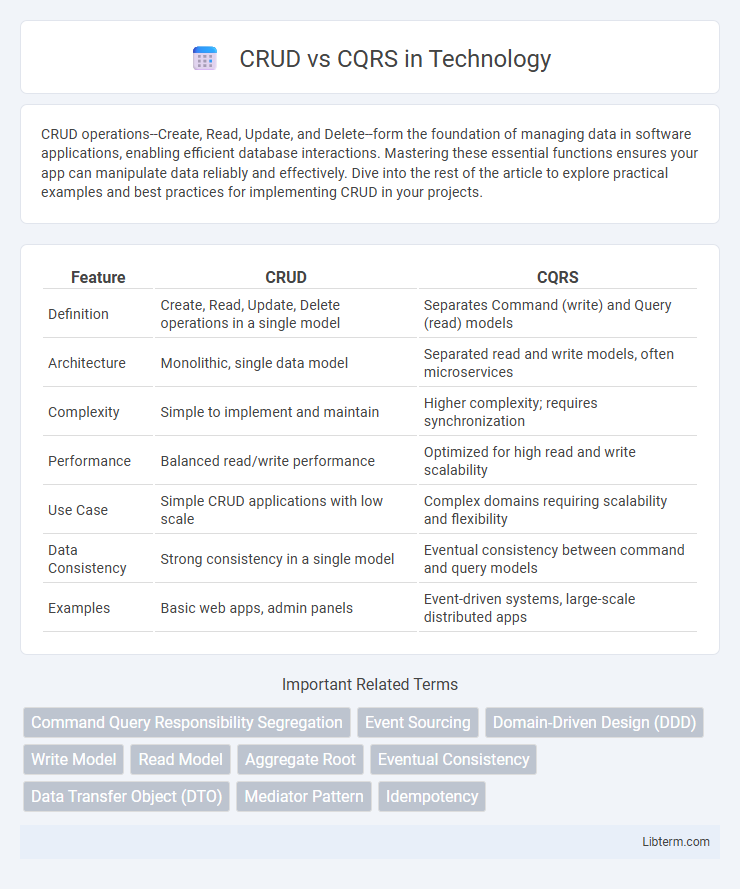CRUD operations--Create, Read, Update, and Delete--form the foundation of managing data in software applications, enabling efficient database interactions. Mastering these essential functions ensures your app can manipulate data reliably and effectively. Dive into the rest of the article to explore practical examples and best practices for implementing CRUD in your projects.
Table of Comparison
| Feature | CRUD | CQRS |
|---|---|---|
| Definition | Create, Read, Update, Delete operations in a single model | Separates Command (write) and Query (read) models |
| Architecture | Monolithic, single data model | Separated read and write models, often microservices |
| Complexity | Simple to implement and maintain | Higher complexity; requires synchronization |
| Performance | Balanced read/write performance | Optimized for high read and write scalability |
| Use Case | Simple CRUD applications with low scale | Complex domains requiring scalability and flexibility |
| Data Consistency | Strong consistency in a single model | Eventual consistency between command and query models |
| Examples | Basic web apps, admin panels | Event-driven systems, large-scale distributed apps |
Introduction to CRUD and CQRS
CRUD (Create, Read, Update, Delete) represents the foundation of database operations, enabling basic manipulation of data through straightforward commands. CQRS (Command Query Responsibility Segregation) separates the system's read and write operations into distinct models, optimizing performance and scalability for complex applications. Understanding CRUD provides a baseline for managing data while CQRS offers advanced architectural benefits by decoupling commands from queries.
Defining CRUD: Core Concepts
CRUD represents the fundamental operations of data management: Create, Read, Update, and Delete, essential for interacting with databases. Each operation corresponds to a specific action--Create adds new records, Read retrieves data, Update modifies existing information, and Delete removes records permanently. These core concepts provide the foundation for traditional application design and data manipulation within relational databases.
Understanding CQRS: Key Principles
CQRS (Command Query Responsibility Segregation) separates the read and write operations into distinct models to optimize performance, scalability, and security compared to traditional CRUD (Create, Read, Update, Delete) approaches. The key principle of CQRS is dividing the system into command handling for writes and query handling for reads, enabling specialized data storage and processing strategies for each. This separation reduces complexity in complex domains, facilitates event sourcing, and improves responsiveness in high-load applications.
Core Differences Between CRUD and CQRS
CRUD (Create, Read, Update, Delete) architecture manages data with simple, unified operations directly on a database. CQRS (Command Query Responsibility Segregation) separates write operations (commands) from read operations (queries), optimizing scalability and performance by using distinct data models for updates and retrievals. The core difference lies in CRUD's single model handling all operations versus CQRS's dedicated paths enhancing complexity management and system responsiveness.
Benefits of Using CRUD
CRUD architecture simplifies database operations by providing a unified and intuitive framework for creating, reading, updating, and deleting data, which accelerates development and reduces complexity. Its straightforward implementation ensures compatibility with most relational databases and standard APIs, facilitating easier maintenance and scalability. This simplicity makes CRUD ideal for applications with basic data manipulation needs and low latency requirements.
Advantages of Adopting CQRS
CQRS improves system scalability and performance by separating read and write workloads, allowing each to be optimized independently. It enhances security and maintainability by isolating commands from queries, reducing complexity and potential side effects. CQRS also facilitates better domain modeling and supports event sourcing, enabling improved auditing and system state reconstruction.
When to Use CRUD in Application Design
CRUD is ideal for applications with straightforward data operations involving Create, Read, Update, and Delete actions on a single data model, ensuring simplicity and ease of implementation. It suits scenarios where transactional consistency and real-time data accuracy are priorities, such as standard web apps, administrative dashboards, and content management systems. CRUD's unified approach reduces complexity and development overhead when business logic is minimal and the domain model does not require separate command and query responsibilities.
Scenarios Ideal for CQRS Implementation
CQRS excels in scenarios with complex domains where read and write workloads differ significantly, such as high-throughput e-commerce platforms or event-driven systems requiring audit trails and history tracking. Systems needing scalability, optimized query performance, and separation of concerns between command processing and query handling benefit from CQRS implementation. Environments demanding concurrent data updates with eventual consistency and asynchronous processing also align well with the CQRS pattern.
Challenges and Drawbacks of CRUD and CQRS
CRUD systems often face challenges with scalability and performance when handling complex business logic and large volumes of data due to their tightly coupled read and write operations. CQRS introduces complexity in maintaining consistency and managing eventual consistency patterns, which can lead to increased development and operational overhead. Both approaches require careful consideration of transaction management, data synchronization, and system latency to avoid potential pitfalls in distributed environments.
Choosing the Right Pattern: CRUD vs CQRS
Choosing between CRUD and CQRS depends on complexity and scalability requirements; CRUD suits simple applications with straightforward data manipulation while CQRS excels in systems demanding clear separation of read and write operations, improving performance and maintainability. CQRS benefits event-driven architectures, enabling asynchronous processing and better handling of complex business rules, whereas CRUD offers simplicity and faster development for basic scenarios. Evaluate data consistency needs, scalability targets, and domain complexity to determine the optimal pattern for your architecture.
CRUD Infographic

 libterm.com
libterm.com